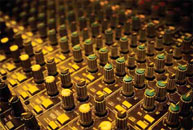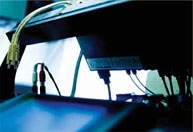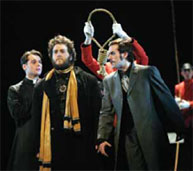A New Dynamic for the Faculty of Music (Page 2)
A New Dynamic for the Faculty of Music (Page 2) McGill University
User Tools (skip):
A New Dynamic for the Faculty of Music (Page 2)



Claudio Calligaris
The McGill Symphony Orchestra is by far the most famous university ensemble in Canada. Now led by the Viennese conductor Alexis Hauser, it performs at a level comparable to that of the Montreal Symphony Orchestra (most principals of which in fact teach at the faculty).
Nor has Opera McGill many rivals. In January of this year, the company staged Harry Somers's patriotic landmark Louis Riel for the first time since a performance in Washington in 1975. Choral music chief Julian Wachner will lead Verdi's extra-large Requiem in April.
Those twin textbook departments, musicology and theory, remain vigorous. Professor Julie Cumming is reviews editor of the Journal of the American Musicological Society while her colleague William Caplin is president-elect of the Society for Music Theory. Newly hired specialists in popular music created a critical mass last November for a symposium on Joni Mitchell, which the artist herself attended while receiving an honorary degree.
With such high standing in these areas - and fresh blood rushing through music education - McGill might not appear to have been in need of much academic expansion. But the prior existence of programs in sound recording (which teaches this craft according to the cultivated, artistic tradition of the European Tonmeister) and music technology (in essence the application of computers to music) suggested to McLean and his colleagues the possibility of creating a new centre that would fuse music and science under a new multidisciplinary and multi-institutional aegis. Thus was born in 2000 the Centre for Interdisciplinary Research in Music Media and Technology, or CIRMMT (pronounced kermit), which will encompass all things sonic.
Should Nagano choose the MMR for a new MSO recording - a prospect McLean has discussed with the conductor personally - there will surely be graduate students in attendance as apprentices and observers. The same holds true for film scores. McLean calls the MMR a "sound-scoring stage," linking it ancestrally with great studios like MGM and Paramount. It is significant that Shawn Murphy, Steven Spielberg's sound engineer, was an early consultant in the project.
 Montreal Symphony Orchestra artistic director Kent Nagano is already interested in recording in the new McGill studio. |
 A scene from Opera McGill's recent production of Harry Somers's Louis Riel at Montreal's Place des Arts. |
If the MMR is the heart of the enterprise, it is not its only major component. The nearby Wirth Opera Rehearsal Room is outfitted with a sprung floor for ballet. Cameras and laser tracing units will facilitate the investigation of motion, whether by dancers or by musicians, whose movements can be correlated exactly with the sounds they make.
Research is by no means confined to members of the Faculty of Music. Robert Zatorre of the Montreal Neurological Institute and colleagues at the Université de Montréal will use CIRMMT resources to study audio processing and the nature of musical intellect. Caroline Palmer of McGill's Department of Psychology, herself a former piano student, is looking into how pianists sequence finger motions and memorize music.
At the hard-wire end, CIRMMT mathematicians and computer scientists are already studying new methods of transmitting and preserving sound data as the once-revolutionary compact disc starts to feel its age. "This is important because we are seeing a real convergence of consumer electronics," McLean says, "whether cell phones, data transmission or the Internet. What's unique about us is that we are in a position both to provide the musical content and to push the technology itself."
McLean hopes this spirit of convergence between musical scientists and scientific musicians will placate traditional concert artists and researchers who feel they are at the losing end of a hostile takeover. "The next generation of musicians has to be as comfortable in a research and recording environment as on stage," says McLean, a strong sympathizer with Glenn Gould's vision of a technological musical future. "In our contemporary environment, it is pointless to be a live musician without sensibility to, and training in, the recording experience."
If it all sounds a tad abstract and science-fictional, this is the nature of a progressive research centre. While CIRMMT will surely occasion some good recordings and ambitious Internet broadcasts, it is not in the business of creating products but of training future scholars and developing new technology.
"Think of pharmaceuticals," McLean says. "Basic research done in universities doesn't necessarily turn into a consumer product just a few years later. But it is still in the interest of the industry to foster university work. We have the luxury of a longer timeline."
Since the official opening is slated for September, after the library moves across Sherbrooke Street, McLean does not have time in infinite abundance. The Canada Foundation for Innovation, a federal agency that normally concerns itself only with science, in partnership with Recherche Québec has given the faculty $6.5 million - unprecedented support for a project involving the arts - while the Quebec Ministry of Research and Development has come forward with an additional $5 million. McGill has so far found $10 million in private funding, but McLean points out that there remains an extraordinary naming opportunity for the building itself.
"McGill still refers to this project as the New Music Building. What we need is for Mister New or Madame Nouvelle to take up this cause," quips the dean. Another $10 million is all it would take to buy marquee rights and cover the $50-million bill.
Once named, the building will have to work, and the faculty will have to prosper. This means maintaining a dual commitment to music and technology. "If you're making a decision between hiring an engineer and a violinist, it's a fine balance," says McLean. "The integration of science and the performing arts is the key. It is a question of making sure that individuals collaborate, that people fit.
"We've been successful so far."
Arthur Kaptainis is music critic for the Montreal Gazette.


